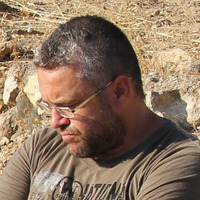- Phoenician Punic Religion, Archaeoastronomy, Mediterranean prehistory, Religion and ritual in prehistory, Balearic prehistory, Aegean Prehistory (Archaeology), and 8 moreIberian Prehistory (Archaeology), Early Bronze Age, Phoenician Punic Archaeology, Ictiology, Ictiofauna, Archaeoichtyology, Sociology of Fisheries and Aquaculture, and Fishing in antiquityedit
Research Interests:
Research Interests:
Research Interests:
Research Interests:
Some of the most common archaeological features on the island of Eivissa, almost omnipresent, are Punic-age cultivation trenches. The characteristics of the island's surface ground made necessary the creation of a system of long... more
Some of the most common archaeological features on the island of Eivissa, almost omnipresent, are Punic-age cultivation trenches. The characteristics of the island's surface ground made necessary the creation of a system of long parallel trenches that allowed ...
Research Interests:
Research Interests:
There are several marine remains throughout the Coves de Santa Maira archaeological sequence which are indicative of relationships with the coastal lowlands. We studied the Mesolithic remains of fish and molluscs species found so far. It... more
There are several marine remains throughout the Coves de Santa Maira archaeological sequence which are indicative of relationships with the coastal lowlands. We studied the Mesolithic remains of fish and molluscs species found so far. It is a small sample, but interesting because it has allowed us to analyze the areas of obtaining these marine resources and suggest any reflection on their significance within the techno-economic transformation processes of the later prehistoric foragers.
Research Interests:
Research Interests:
La excavacion de la granja punica de Truncu’e Molas (Cerdena) en el verano de 2007 ha permitido, a pesar de estar muy arrasado el asentamiento, la recuperacion de un conjunto de materiales ceramicos y liticos, ademas de restos... more
La excavacion de la granja punica de Truncu’e Molas (Cerdena) en el verano de 2007 ha permitido, a pesar de estar muy arrasado el asentamiento, la recuperacion de un conjunto de materiales ceramicos y liticos, ademas de restos bioarqueologicos. Con todo ello se puede hacer un acercamiento a los sistemas empleados en ese ambito rural punico para la elaboracion y preparacion de alimentos en los ss. IV-III a.J.C. La aproximacion a las tecnicas de cocina la realizamos fundamentalmente a partir de los elementos muebles, como las ollas, las cazuelas y el tannur , mientras que el estudio de los materiales bioarqueologicos nos muestra a una comunidad que aunque esta especializada en la produccion de vino, obtiene la mayor parte de sus recursos alimenticios del entorno inmediato.
Research Interests:
The exploitation of fishery resources on the Mediterranean coast of the Ibe-rian Peninsula throughout recent prehistory, is a very poorly known subject of which we have hardly any data. The shortage of good archaeological records,... more
The exploitation of fishery resources on the Mediterranean coast of the Ibe-rian Peninsula throughout recent prehistory, is a very poorly known subject of which we have hardly any data. The shortage of good archaeological records, involving the recovery of fish remains, has long weighed the investigations. However, some developments of recent years could indicate an improvement in this regard. To this we must add the isotope analysis, which complements the direct information obtained by the fish remains. We present here a complete and interpretative study of all the data we currently have in this field of study. INTRODUCCIÓN Parece una temeridad abordar en un artículo un hecho tan significativo como la pesca, en un periodo de tiempo tan dilatado; son prácticamente 7000 años. Sin embargo, el estado actual de las investigaciones respecto al tema que nos ocupa, esta lejos de ser el deseado, y muestra más lagu-nas (en realidad océanos) que respuestas, lo que no nos permite obtener la perspectiva deseada, pero sí relatar en detalle el statu quo en un traba-jo de síntesis como este. En este análisis, para no forzar un encuadre geográfico hispánico, artificial y más amplio, que englobará incluso diferentes mares, se ha optado Recursos marins en el passat. IV Jornades d'arqueozoologia. Museu de Prehistòria de València (2019): 135-164.
Research Interests:
Research Interests:
Estudio de las ictiofaunas de la Pobla medieval de Ifach
